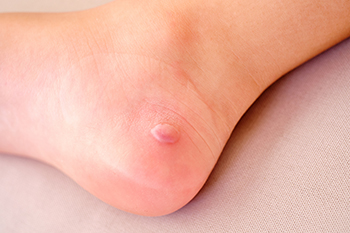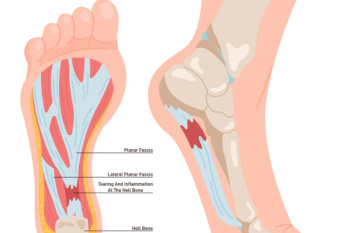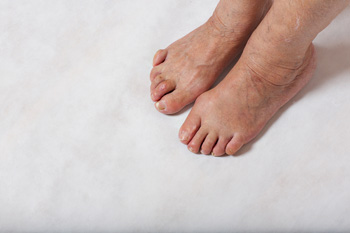Connect With Us
Blog
Why Did I Get a Foot Blister?

A foot blister is a small, fluid-filled sac that forms on the skin due to irritation or damage. It is often caused by friction, which occurs when shoes or socks repeatedly rub against the skin. Heat and moisture can also contribute to blister formation, especially in warm environments where excessive sweating softens the skin. Allergic reactions to certain materials in footwear or socks may trigger blisters as well. Some medical conditions, such as diabetes, eczema, or infections, can make individuals more prone to developing blisters. Symptoms include redness, swelling, tenderness, and a sensation of warmth surrounding the affected area. Blisters can become infected and may cause difficulty in completing daily activities. If you have a blister anywhere on your foot, it is suggested that you contact a podiatrist who offers safe and sterile treatment before it becomes infected.
Blisters may appear as a single bubble or in a cluster. They can cause a lot of pain and may be filled with pus, blood, or watery serum. If your feet are hurting, contact one of our podiatrists of Foot & Ankle Associates of Maine. Our doctors can provide the care you need to keep you pain-free and on your feet.
Foot Blisters
Foot blisters are often the result of friction. This happens due to the constant rubbing from shoes, which can lead to pain.
What Are Foot Blisters?
A foot blister is a small fluid-filled pocket that forms on the upper-most layer of the skin. Blisters are filled with clear fluid and can lead to blood drainage or pus if the area becomes infected.
Symptoms
(Blister symptoms may vary depending on what is causing them)
- Bubble of skin filled with fluid
- Redness
- Moderate to severe pain
- Itching
Prevention & Treatment
In order to prevent blisters, you should be sure to wear comfortable shoes with socks that cushion your feet and absorb sweat. Breaking a blister open may increase your chances of developing an infection. However, if your blister breaks, you should wash the area with soap and water immediately and then apply a bandage to the affected area. If your blisters cause severe pain it is important that you call your podiatrist right away.
If you have any questions, please feel free to contact our office located in Brunswick, ME . We offer the newest diagnostic and treatment technologies for all your foot care needs.
Understanding Plantar Fasciitis

Plantar fasciitis causes pain and inflammation in the thick band of tissue running along the bottom of the foot. This tissue, known as the plantar fascia, connects the heel to the toes and helps support the arch. Repetitive strain or excessive pressure can cause small tears in the fascia, leading to irritation and discomfort. The pain is often felt near the heel and is typically worse in the morning or after long periods of rest. Risk factors include prolonged standing, high-impact activities, improper footwear, and foot structure abnormalities like flat feet or high arches. Plantar fasciitis can cause severe pain and discomfort, and it may become difficult to complete daily activities. If you have heel pain, it is strongly suggested that you promptly consult a podiatrist who can accurately diagnose and treat this condition.
Plantar fasciitis is a common foot condition that is often caused by a strain injury. If you are experiencing heel pain or symptoms of plantar fasciitis, contact one of our podiatrists from Foot & Ankle Associates of Maine. Our doctors can provide the care you need to keep you pain-free and on your feet.
What Is Plantar Fasciitis?
Plantar fasciitis is one of the most common causes of heel pain. The plantar fascia is a ligament that connects your heel to the front of your foot. When this ligament becomes inflamed, plantar fasciitis is the result. If you have plantar fasciitis you will have a stabbing pain that usually occurs with your first steps in the morning. As the day progresses and you walk around more, this pain will start to disappear, but it will return after long periods of standing or sitting.
What Causes Plantar Fasciitis?
- Excessive running
- Having high arches in your feet
- Other foot issues such as flat feet
- Pregnancy (due to the sudden weight gain)
- Being on your feet very often
There are some risk factors that may make you more likely to develop plantar fasciitis compared to others. The condition most commonly affects adults between the ages of 40 and 60. It also tends to affect people who are obese because the extra pounds result in extra stress being placed on the plantar fascia.
Prevention
- Take good care of your feet – Wear shoes that have good arch support and heel cushioning.
- Maintain a healthy weight
- If you are a runner, alternate running with other sports that won’t cause heel pain
There are a variety of treatment options available for plantar fasciitis along with the pain that accompanies it. Additionally, physical therapy is a very important component in the treatment process. It is important that you meet with your podiatrist to determine which treatment option is best for you.
If you have any questions, please feel free to contact our office located in Brunswick, ME . We offer the newest diagnostic and treatment technologies for all your foot care needs.
Causes and Treatment of Bunions

A bunion, medically known as hallux valgus, is a bony prominence that forms at the base of the big toe when the top of the toe shifts inward toward the others. This misalignment can lead to pain, swelling, redness, and difficulty wearing certain shoes. As a bunion progresses, the joint may become stiff, making simple movement uncomfortable. Some people also develop corns or calluses due to increased friction on the affected area. Contributing factors to bunion formation include inherited foot structure, flat feet, joint conditions such as rheumatoid arthritis, and aging. Although wearing tight or high-heeled shoes do not directly cause bunions, they can place additional stress on the foot, worsening symptoms. A podiatrist can assess the severity of a bunion and offer treatment to relieve pain and improve foot function. Options include padding, custom orthotics, or footwear modifications. In cases where pain is persistent or mobility is limited, surgery may be necessary to realign the toe. If you have a bunion that is interfering with daily activities, it is suggested that you schedule an appointment with a podiatrist for an exam, diagnosis, and treatment options, which may include surgery.
If you are suffering from bunion pain, contact one of our podiatrists of Foot & Ankle Associates of Maine. Our doctors can provide the care you need to keep you pain-free and on your feet.
What Is a Bunion?
Bunions are painful bony bumps that usually develop on the inside of the foot at the joint of the big toe. As the deformity increases over time, it may become painful to walk and wear shoes. Women are more likely to exacerbate existing bunions since they often wear tight, narrow shoes that shift their toes together. Bunion pain can be relieved by wearing wider shoes with enough room for the toes.
Causes
- Genetics – some people inherit feet that are more prone to bunion development
- Inflammatory Conditions - rheumatoid arthritis and polio may cause bunion development
Symptoms
- Redness and inflammation
- Pain and tenderness
- Callus or corns on the bump
- Restricted motion in the big toe
In order to diagnose your bunion, your podiatrist may ask about your medical history, symptoms, and general health. Your doctor might also order an x-ray to take a closer look at your feet. Nonsurgical treatment options include orthotics, padding, icing, changes in footwear, and medication. If nonsurgical treatments don’t alleviate your bunion pain, surgery may be necessary.
If you have any questions, please feel free to contact our office located in Brunswick, ME . We offer the newest diagnostic and treatment technologies for all your foot care needs.
Early Podiatry Visits for Bunion and Hammertoe Correction

Patients undergoing combined bunion and hammertoe surgery often experience more pain and slower recovery than those who have bunion correction alone. Research shows that those individuals with both conditions tend to have more severe foot deformities preoperatively and see less improvement in pain levels post-surgery. Since bunions can contribute to hammertoe formation, early intervention is key. Signs such as the second toe lifting or pain beneath the second metatarsal head may indicate worsening deformity. Addressing bunions before hammertoes develop may help prevent the need for additional surgical correction. If you are noticing changes in your toe alignment or have increased discomfort, it is suggested that you consult a podiatrist for better long-term outcomes and a smoother recovery process.
Hammertoe
Hammertoes can be a painful condition to live with. For more information, contact one of our podiatrists from Foot & Ankle Associates of Maine. Our doctors will answer any of your foot- and ankle-related questions.
Hammertoe is a foot deformity that affects the joints of the second, third, fourth, or fifth toes of your feet. It is a painful foot condition in which these toes curl and arch up, which can often lead to pain when wearing footwear.
Symptoms
- Pain in the affected toes
- Development of corns or calluses due to friction
- Inflammation
- Redness
- Contracture of the toes
Causes
Genetics – People who are genetically predisposed to hammertoe are often more susceptible
Arthritis – Because arthritis affects the joints in your toes, further deformities stemming from arthritis can occur
Trauma – Direct trauma to the toes could potentially lead to hammertoe
Ill-fitting shoes – Undue pressure on the front of the toes from ill-fitting shoes can potentially lead to the development of hammertoe
Treatment
Orthotics – Custom made inserts can be used to help relieve pressure placed on the toes and therefore relieve some of the pain associated with it
Medications – Oral medications such as anti-inflammatories or NSAIDs could be used to treat the pain and inflammation hammertoes causes. Injections of corticosteroids are also sometimes used
Surgery – In more severe cases where the hammertoes have become more rigid, foot surgery is a potential option
If you have any questions please contact our office located in Brunswick, ME . We offer the newest diagnostic and treatment technologies for all your foot and ankle needs.
